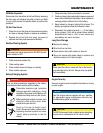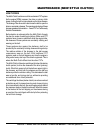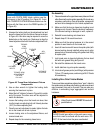
PAGE 36 — HHXD5 RIDE-ON TROWEL • OPERATION MANUAL — REV. #2 (05/04/12)
HOW IT WORKS
The Multi-Clutch functions much like a standard CVT system.
As the engine RPM’s increase, the drive or primary clutch
closes, forcing the belt to ride outwards on the drive sheaves.
The closing of the drive clutch also forces the belt to open the
driven or secondary sheaves. The opening and closing of these
sheaves creates a ratio variation… hence CVT or Continuously
Variable Transmission.
Belt protection is achieved within the Multi-Clutch through
the use of a series of centrifugal clutches. While most CVT
systems have a loose or slack belt while the engine idles,
the sheaves of those systems are constantly rotating and
wearing on the belt.
Those systems also require the stationary belt to be
pinched by the constantly rotating sheaves during startup.
The relative rotation of the sheaves to the belt causes
unnecessary wear on the belt. With traditional CVT
systems, wear on the belt happens any time the engine is
idling and at every start up of the driven equipment. This is
where the Multi-Clutch differs from the other CVT’s.
The Multi-Clutch utilizes two centrifugal clutches (the starter
clutch system) to drive the sheaves of the drive (primary)
clutch. What that means is that the belt can remain tight in
the sheaves, and that both the sheaves and the belt are
stationary while the vehicle is idling. This eliminates the belt
wear at an idle, and during start up, while also providing
one additional form of belt protection.
The centrifugal clutches (starter clutch) can act as overload
protection as well. In cases where too much torque is trying
to be transmitted to the belt, the centrifugals can slip before
the maximum load on the belt is achieved. What this means
is that instead of the belt slipping on the sheaves during
an overload, the centrifugals will first slip further protecting
the belt from damage.
MAINTENANCE (NEW STYLE CLUTCH)


















